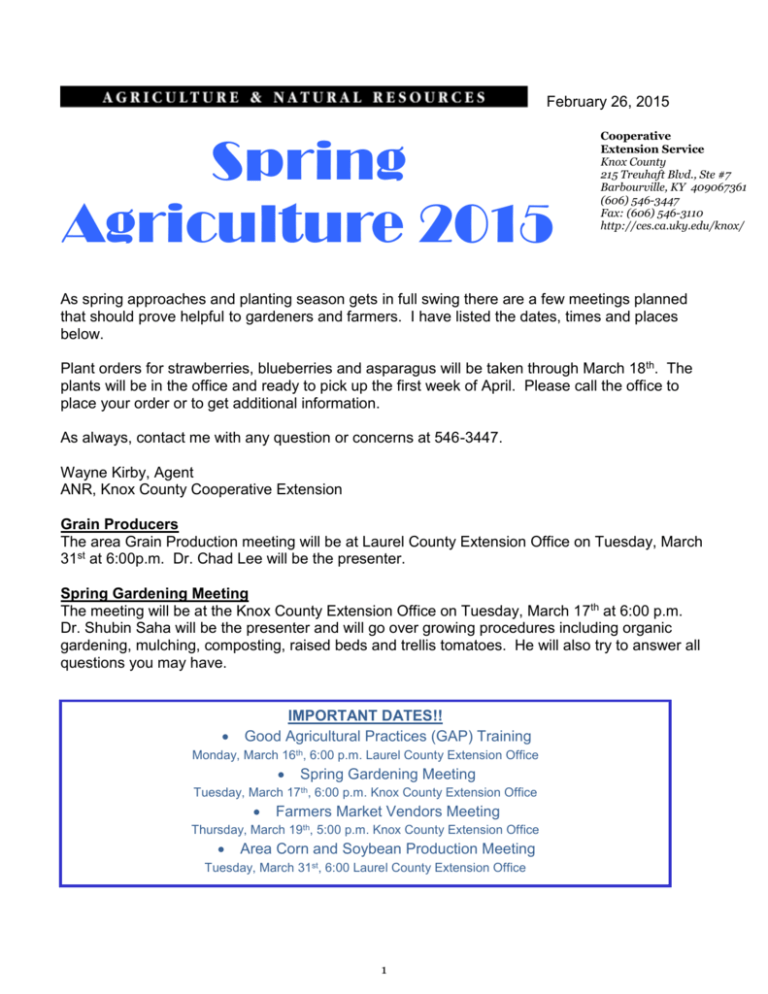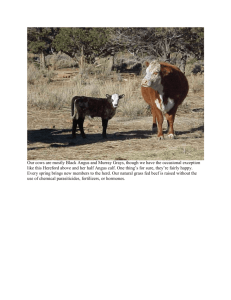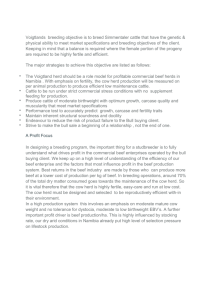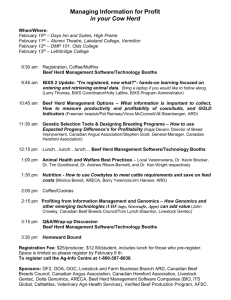Spring 2015 Newsletter - Knox County Cooperative Extension
advertisement

February 26, 2015 Spring Agriculture 2015 Cooperative Extension Service Knox County 215 Treuhaft Blvd., Ste #7 Barbourville, KY 409067361 (606) 546-3447 Fax: (606) 546-3110 http://ces.ca.uky.edu/knox/ As spring approaches and planting season gets in full swing there are a few meetings planned that should prove helpful to gardeners and farmers. I have listed the dates, times and places below. Plant orders for strawberries, blueberries and asparagus will be taken through March 18th. The plants will be in the office and ready to pick up the first week of April. Please call the office to place your order or to get additional information. As always, contact me with any question or concerns at 546-3447. Wayne Kirby, Agent ANR, Knox County Cooperative Extension Grain Producers The area Grain Production meeting will be at Laurel County Extension Office on Tuesday, March 31st at 6:00p.m. Dr. Chad Lee will be the presenter. Spring Gardening Meeting The meeting will be at the Knox County Extension Office on Tuesday, March 17th at 6:00 p.m. Dr. Shubin Saha will be the presenter and will go over growing procedures including organic gardening, mulching, composting, raised beds and trellis tomatoes. He will also try to answer all questions you may have. IMPORTANT DATES!! Good Agricultural Practices (GAP) Training Monday, March 16th, 6:00 p.m. Laurel County Extension Office Spring Gardening Meeting Tuesday, March 17th, 6:00 p.m. Knox County Extension Office Farmers Market Vendors Meeting Thursday, March 19th, 5:00 p.m. Knox County Extension Office Area Corn and Soybean Production Meeting Tuesday, March 31st, 6:00 Laurel County Extension Office 1 2014 KENTUCKY REVIEW • KY ag cash receipts will total $6 billion in 2014, compared to the 2013 adjusted official USDA level of $5.7 billion. • KY crop receipts are forecast at $2.8 billion (-2%) benefiting from higher priced 2013 crops sold in 2014. • Strong beef, dairy, poultry and hog prices boosted KY livestock receipts to a record $3.2 billion (+15%). • KY net cash income (cash receipts + government payments – cash expenses) may retreat from the 2013 record high level but will remain relatively strong. • World burley production increased 12% in 2014, following a 22% larger crop in 2013, with most of the growth in low quality/filler tobacco from Africa (Universal Leaf Company estimates). • USDA estimates the 2014 U.S. burley crop at 211.5 million pounds, 10% above the 2013 crop. • U.S. burley disappearance (domestic use plus exports) was relatively stable at around 210 to 220 million pounds from 2008-2012, but fell to 200 million pounds in 2013 and will likely fall farther in the 2014 marketing year responding to both lower leaf exports and slumping domestic cigarette sales. • Despite a crop that most buyers expect to be smaller than current USDA estimate, 2014 U.S. burley production will still likely be greater than anticipated use; leading to more critical grading and prices retreating from their record high of $2.06/lb for the 2013 crop. • The 2014 U.S. dark fire cured crop is expected to total around 50 million pounds, and the 2014 U.S. dark air-cured crop totaling around 15 million pounds (just slightly above last year’s levels). • Expansion in smokeless tobacco consumption appears to be slowing in 2014, but the current supply/demand balance for dark tobaccos indicates relatively strong leaf prices for the current crop ($2.65-$2.70/lb for top quality dark-fire and $2.35-$2.40/lb for dark-air). • Lower burley demand, coupled with a mixed quality crop, will likely cause the value of 2014 production to fall below $400 million. (SOURCE: UK Dept. of Agricultural Economics 2014-2015 Agricultural Situation & Outlook) Timely Beef Tips Dr. Roy Burris, Beef Extension Professor, University of Kentucky General Provide water at all times. Watch for frozen pond hazards. If cattle are watering in a pond, be sure to keep ice “chopped” to keep cattle from walking on the ice and, possibly, breaking through. Increase feed as temperature drops. When temperature falls below 15 degrees, cattle need access to windbreaks. For each 10 degree drop below 15 degrees, add three pounds of hay, two pounds of corn, or six pounds of silage to their rations. You should be feeding a mineral supplement with adequate magnesium to prevent grass tetany (~ 15% Mg) now. The Hi-mag UK Beef IRM mineral can be used now. Start looking for herd sire replacements, if needed. Control lice. Watch for signs such as rubbing. Begin pasture renovation. You can overseed clover on frozen or snow-covered pastures. 2 Beef Herd Expansion Appears to be Underway Dr. Kenny Burdine, Livestock Marketing Specialist, University of Kentucky USDA released their annual cattle inventory estimates in late January. This report was especially significant this year as many were looking for confirmation that beef herd expansion had begun. Overall, the report indicated that expansion was underway, and perhaps at a faster pace than many expected. Also, the report confirmed that the cow herd was larger coming into 2015, likely as a result of decreased cow slaughter during 2014. Total cattle and calves were estimated up by about 1% from 2014. Estimates are shown in the table at the end of this article and include both 2014 and 2015. The number that will likely have the most immediate impact on beef producers is the estimated size of the beef cow herd. The January 2015 estimate was just under 29.7 million, which was an increase of a little more than 2% from 2014. Sizeable increases were seen in Texas, Oklahoma and Kansas. Increases in herd size in the southeast were more moderate for the most part. Cow slaughter had been running well below year ago levels for virtually all of 2014 and I think this was the primary driver of the increase in cow numbers. Deep culling in much of the US during 2011-2013 resulted in beef producers coming into 2014 with a younger cow herd. The combination of a younger herd, favorable weather, and attractive calf prices likely resulted in producers simply culling fewer cows in 2014. The impact will be a larger calf crop being marketed in the US for 2015, which will have an impact on calf prices this fall. The other number that has gotten a lot of attention was a 4% increase in the number of heifers held for beef cow replacement. Heifer retention was also slightly above year ago levels last year, but by a smaller percentage. Further, I felt that some of the increase in heifer retention last year was partially in response to deceasing cow numbers. Conversely, the heifer retention seen this year occurred when total beef cow numbers had actually increased. To put this 4% in perspective, it amounts to an additional 226,000 more heifers being held for beef cow replacements. As a percentage of the 29.7 million US beef cow herd, this would be slightly less than 1%. Heifer development estimates for July will also be of importance as we start thinking about how quickly this cow-herd will grow. Of course, so will weather conditions in the coming years and how well the calf market holds as production starts to increase and the beef market sees increased pressure from competing meats. The Kentucky numbers told a story similar to what most would have expected – the Kentucky beef cow herd has grown, but at a more moderate pace than the Southern Plains. The estimated size of Kentucky’s beef cow herd came in 2% higher than January 2014, but that was after a 2% reduction in the 2014 estimate. So, the Kentucky beef cow herd is about where it was estimated to be last year – just over one million cows. While this report confirms that beef cow herd expansion is underway, many of the fundamentals remain positive for the beef sector in 2015. I fully expect calf prices to respond positively to grass this spring and think we are likely to see the strongest spring calf market that we have seen. While I do look for fall calf prices to be softer in fall 2015, I also fully expect the fall 2015 market to another strong one, second only to the fall of 2014. Cow-calf operators should take advantage of the increased income they enjoyed in 2014 and are likely to enjoy in 2015 to get their beef herds where they want them to be in the next few years. 3 PRESORTED STANDARD US POSTAGE PAID BARBOURVILLE, KY PERMIT # 33 Cooperative Extension Service University of Kentucky Knox County 215 Treuhaft Blvd., Ste # 7 Barbourville, KY 40906-7361 RETURN SERVICE REQUESTED 4







